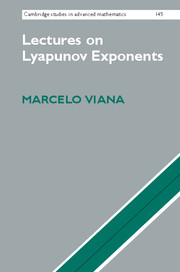4 - Multiplicative ergodic theorem
Published online by Cambridge University Press: 05 July 2014
Summary
This chapter is devoted to the fundamental result in the theory of Lyapunov exponents: the multiplicative ergodic theorem of Oseledets [92]. The statements are given in Section 4.1 and proofs appear in Section 4.2 (one-sided version, for general cocycles) and Section 4.3 (two-sided version, for invertible cocycles). Some related issues are discussed in Section 4.4.
Throughout, we take (M, B, μ) to be a complete separable probability space. Recall that complete means that any subset of a measurable set with zero measure is measurable (and has zero measure) and separable means that there exists a countable family E ⊂ B such that for any ɛ > 0 and any B ∈ B there exists E ∈ E such that μ(BΔE) < ɛ.
Let F : M × ℝd → M × ℝd be the linear cocycle defined by a measurable function A : M → GL(d) over a measurable transformation f : M → M that preserves the probability measure μ. It is assumed that the functions log+||A±1|| are integrable with respect to μ.
Statements
Recall that the Grassmannian of ℝd is the disjoint union Gr(d) of the Grassmannian manifolds Gr(l, d), 0 ≤ l ≤ d. A map x ↦ Vx with values in Gr(d) is measurable if and only if there exist measurable, linearly independent vector fields that span Vx at each point (Exercise 4.1).
- Type
- Chapter
- Information
- Lectures on Lyapunov Exponents , pp. 38 - 66Publisher: Cambridge University PressPrint publication year: 2014

